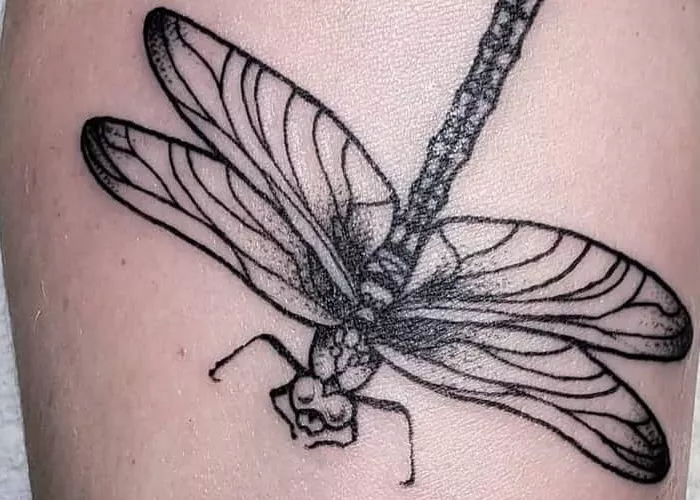In the vast tapestry of tattoo art, dragonfly tattoos stand out for their intricate beauty and profound symbolism. In Buddhist philosophy, the dragonfly holds a unique spiritual significance, representing transformation, impermanence, and mindfulness. As tattoo art continues to evolve, dragonflies have become a popular choice for individuals seeking a design that encapsulates deep philosophical meaning.
In this article, we will explore the nuanced interpretations of the dragonfly tattoo within the context of Buddhism. Through its connection to impermanence, self-realization, mindfulness, and the interconnection of life, the dragonfly tattoo embodies powerful lessons that resonate deeply with Buddhist teachings. By understanding these connections, one can appreciate how a seemingly delicate design conveys profound spiritual truths.
Dragonflies and Impermanence in Buddhist Philosophy
A central tenet of Buddhism is the concept of impermanence, or anicca. This doctrine teaches that all things are transient, subject to change, and ultimately fleeting. The dragonfly, with its short lifespan and swift, graceful movements, becomes a perfect metaphor for this impermanence.
In the natural world, a dragonfly’s life begins underwater as a nymph, undergoing a remarkable transformation before it takes flight. This metamorphosis mirrors the transient nature of existence—a key lesson in Buddhism that encourages practitioners to embrace change rather than resist it.
A dragonfly tattoo, therefore, serves as a reminder of the ephemeral nature of life and the importance of living in the present moment. For Buddhists, it symbolizes the acceptance of life’s transitory nature and the understanding that clinging to material possessions or fixed identities leads to suffering.
Dragonflies as Symbols of Self-Realization
In Buddhism, self-realization is the journey of recognizing the illusory nature of the ego and achieving a deeper understanding of one’s true self. The dragonfly’s ability to navigate air and water—two vastly different elements—symbolizes adaptability and transformation.
Dragonflies often change direction swiftly and effortlessly, reflecting the fluidity required in the pursuit of spiritual growth. A dragonfly tattoo can represent an individual’s journey toward enlightenment and their commitment to self-awareness.
Furthermore, the iridescent wings of the dragonfly hold symbolic meaning. The shifting colors remind one of the multifaceted nature of existence and the layers of perception that one must peel away to uncover ultimate truth. In this sense, the dragonfly is a beacon for those striving for spiritual awakening and the courage to face inner truths.
Mindfulness and Presence Through the Dragonfly’s Movement
The dragonfly’s flight is often described as purposeful and precise. In Buddhism, such focused movement is a reflection of mindfulness—the practice of living fully in the present moment. The dragonfly’s ability to hover, dart, and remain still aligns with the Buddhist teaching of maintaining awareness in all states of being.
A tattoo of a dragonfly can be a powerful symbol of mindfulness, reminding the wearer to center themselves in the here and now. Just as the dragonfly’s every movement is deliberate, practitioners of Buddhism strive to bring intentionality and awareness to their thoughts, actions, and surroundings.
Additionally, the dragonfly’s role in nature—flitting across ponds and resting gently on still waters—evokes the calm and serenity sought in meditation practice. A dragonfly tattoo thus becomes a visual cue to pause, breathe, and engage fully with life as it unfolds.
The Dragonfly and Interconnectedness of Life
In Buddhist philosophy, the interconnectedness of all beings and phenomena is a fundamental truth. This concept, known as dependent origination or pratītyasamutpāda, underscores the idea that everything exists in relation to something else.
The dragonfly’s ecological role highlights this interconnectedness. It is both a predator and prey, contributing to the delicate balance of ecosystems. This dual role mirrors the Buddhist understanding of interdependence—that every action and existence has ripple effects on the larger web of life.
A dragonfly tattoo, in this context, symbolizes harmony and balance, urging the wearer to honor their place within the broader network of existence. It serves as a reminder of the responsibility to live compassionately and in harmony with others.
Conclusion
The dragonfly tattoo is far more than a striking piece of body art; it is a profound symbol deeply embedded in Buddhist teachings. Through its connection to impermanence, self-realization, mindfulness, and the interconnectedness of life, the dragonfly carries spiritual lessons that resonate across cultures and philosophies.
For those who choose a dragonfly tattoo, it becomes a personal emblem of transformation, awareness, and the quest for harmony within oneself and the universe. As with all tattoos, its meaning is deeply personal, but its roots in Buddhist philosophy provide a rich, layered understanding for both the wearer and the observer.
Whether as a mark of spiritual growth or a reminder of life’s fleeting beauty, the dragonfly tattoo offers a timeless connection to the wisdom of Buddhism. It stands as a testament to the enduring power of symbols and their ability to communicate the ineffable truths of human existence.
Related topics:

